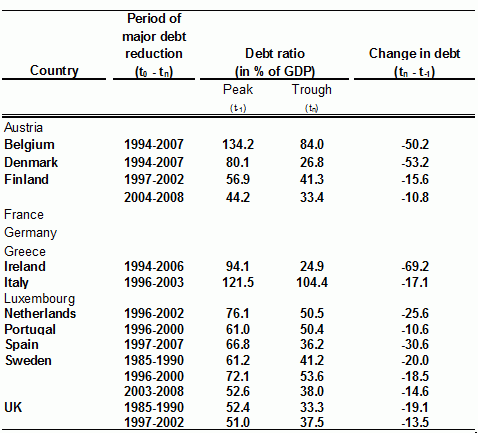With world markets raising concern over the huge fiscal imbalances, the policy debate is focusing its attention on how to reduce debt in as successful and sustainable a way as possible (Corsetti 2010, Ruiz-Arranz 2010, Aizenmann and Pasricha 2010).
One major concern about rising debt ratios relates to their sustainability. As debt ratios increase, investor confidence in governments' creditworthiness may decline. This pushes interest rates up as debt holders demand a higher risk premium, which in turn burdens the sustainability of public debt further. As seen in recent months, this may even culminate in shortages in the availability of financing for certain (mostly highly indebted) countries.
But how can governments find a way out of the current fiscal malaise? Past experience may provide useful guidance here because major public debt reductions have happened before. In a recent paper (Nickel et al. 2010), we take a close look at this past experience. For the successful consolidation experiences in the EU, the average total debt reduction per country amounted to almost 37 percentage points of GDP. Appropriate policies, especially on the expenditure side, helped contribute to this outcome.
Why must high public debt be reduced?
Apart from sustainability concerns, high public debt levels may directly or indirectly harm economic growth. The channel most frequently discussed in this context refers to the crowding-out of private investment. Public debt competes with private debt for the allocation of savings. To the extent that public debt is used to finance productive government expenditure and if the availability of safe and liquid debt instruments drives higher savings this will not necessarily result in lower capital accumulation. However, if the debt-to-GDP ratio increases persistently over time, the newly issued bonds can only be absorbed by the market participants if they yield higher real returns, with a consequent crowding-out of private investment.
Furthermore, high debt levels reduce the flexibility of fiscal policy to respond to economic shocks. Indeed, countries with high debt levels were seen to be more restrictive in their responses to the 2008/2009 financial crisis than countries with relatively lower debt levels. A highly indebted government lacks the fiscal space to stabilise the economic cycle. There is an extended literature showing that disciplined governments tend to deliver better fiscal policy (Fatás and Mihov 2010, Larch and Turrini 2008). Moreover, over-indebted governments will find it difficult to extend credible guarantees to the financial sector (or other agents in the economy) should this become necessary (see discussion in Rother et al. 2010).
How can governments reduce public debt?
Governments of advanced economies have in general a limited number of options to reduce their public debt. On the one hand they can adjust fiscal policies by running sufficient primary budget surpluses to lower their debt. On the other hand they can create an environment conducive to growth through the implementation of sound macroeconomic and structural policies in order to “grow their way out" of indebtedness.
On a side note, inflation is not a viable option for successful public debt reduction. Inflation can only have a short-term effect as its impact on debt works via surprise increases in the price level. Once agents expect further inflation increases, this will be priced in yield expectations and thus burden public finances. Moreover, such poli-cies risk “unanchoring” inflation expectations and thus contributing to macroeconomic instability. From an institutional point of view, central bank independence would risk being undermined, possibly bringing down the credibility of domestic governance structures with it.
How did governments successfully reduce public debt in the past?
Using data for the period 1985-2009 for the EU15, we identify the success factors underlying major public debt reductions.
In a first step, we select the episodes during which the public debt to GDP ratio was reduced during those 25 years. In a second step, we isolate the major (and thus successful) debt reductions from all debt reduction episodes. We define a successful debt reduction as one in which the debt ratio is reduced by more than 10 percentage points cumulatively within five consecutive years. This way we identify 191 episodes of debt reduction, of which 59 episodes represent a major debt reduction according to our definition. Most of the episodes of successful debt reductions span over a relatively long time horizon. In Belgium and Denmark, for example, it took 14 years. The relatively long time span of these episodes indicates that the debt reductions were remarkably large and persistent.
Table 1. Periods of major public debt reduction (1985-2009)
In a third step, we estimate several specifications of a logistic probability model to assess which factors determine the probability of a major debt reduction. Our results:
- First, major debt reductions are mainly driven by decisive and lasting (rather than timid and short-lived) fiscal consolidation efforts focused on reducing government expenditure, in particular, cuts in social benefits and public wage spending. Revenue-based consolidations seem to have a tendency to be less successful.
- Second, robust real GDP growth also increases the likelihood of a major debt reduction because it helps countries to “grow their way out" of indebtedness. Here, the literature also points to a positive feedback effect with decisive expenditure-based fiscal consolidation because this type of consolidation appears to foster growth, in particular in times of severe fiscal imbalances.
- Third, high debt servicing costs exert a disciplinary effect via market forces and require governments to set up credible plans to stop and reverse the increase in debt ratios.
How should governments reduce public debt today?
Our analysis provides several policy recommendations for public debt reductions today. First, drastic and permanent fiscal consolidation mainly concentrating on the expenditure side seems more appropriate than tax increases and timid adjustments. A recent example for such a rapid fiscal adjustment programme could be the current austerity budget of the UK. Second, governments should use an economic upswing for budget consolidation rather than providing tax breaks or other fiscal giveaways. Here an important feedback loop to the type of fiscal consolidation kicks in as expenditure-based fiscal consolidations have proven to be more growth-friendly than revenue-based ones (e.g. Alesina and Perotti 1995 or Giudice et al 2007). The current dire fiscal situation in several European countries requires a significant and permanent consolidation without delay. Indeed, with the appropriate fiscal policies, these countries can foster economic growth and restore fiscal sustainability.
This column appears in German on our partner site Ökonomenstimme.
References
Aizenmann, J and GK Pastricha (2010), “Fiscal fragility: What the past may say about the future”, VoxEU.org, 7 November.
Alesina, A and R Perotti (1995), “Fiscal Expansion and Adjustment in the OECD countries”, Economic Policy, 21:201-247.
Corsetti, Giancarlo (2010), “Fiscal consolidation as a policy strategy to exit the global crisis”, VoxEU.org, 17 June.
European Central Bank (2009), “Experience with Government Debt Reduction in the Euro Area Countries”, Monthly Bulletin Box (September), 86-89.
Fatás, A and I Mihov (2010), “Fiscal policy at a crossroads: The need for constrained discretion”, VoxEU.org, 17 June.
Larch, M and A Turrini (2008): “Received Wisdom and Beyond: Lessons from Fiscal Consolidations in the EU”, European Economy, Economic Papers No 320.
Giudice, G, A Turrini and J in’t Veld (2007), “Non-Keynesian Fiscal Adjustments? A Close Look at Expansionary Fiscal Consolidations in the EU”, Open Economies Re-view, 18(5):613-630.
Nickel, C, P Rother, and L Zimmermann (2010), “Major Public Debt Reductions: Lessons from the Past, Lessons for the Future”, ECB Working Paper Series, 1241.
Rother, P, L Schuknecht, and J Stark (2010), “The benefits of fiscal consolidation in uncharted waters”, ECB Occasional Paper No. 121.
Ruiz-Arranz, M (2010), “Lessons from Large Fiscal Adjustments”, Selected Issues United Kingdom, International Monetary Fund, Washington DC.






